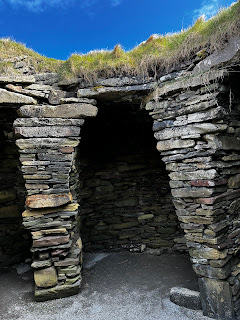We arrived in Lerwick, the capital of the Shetland Islands at 6:30 am, giving us plenty of time to discover the town before our scheduled excursion in the afternoon. The Shetlands consist of over 100 islands, only 16 of them are inhabited. The largest one by far is where we are, with Lerwick being the largest town, with about 9000 inhabitants out of a total of 23,000.
The Shetland's have been part of Scotland since 1468, when the King of Norway was unable to pay the dowry for his daughter, Margaret, who married the son of the King of Scotland. So he loaned Scotland the Shetlands and Orkneys until he could raise the money…. But Scotland refused to give them back, and so here we are today. The Schetandlers will tell you that "we have only been part of Scotland for a short time," and you see many more more Norwegian flags than Scottish ones.
Also, all the street have Norwegian names.
In the town hall (the castle looking thing) which was built in 1883 (that's more than 400 years after the Shetlands became Scottish), there are wonderful stained glass windows, depicting the "entire" history of the Shetlands…. Stopping at Margaret’s wedding, because after that…. Who cares…
These are really beautiful and cover every window of the building. Well worth a the short walk up the hill.
I particularly liked the wheel house (it’s shaped like a wheel). Note the very short entry, meant to keep the fierce storms out... 
You can stumble on its much longer history, as in this Broch (old houses that were built 2000 years ago- more about them later), right across the street from Tesco. …
In the afternoon, we first went to the southern most part of the island, along picturesque roads, dotted with cute villages, sheep farms, with adorable lambs, and, of course, Shetland ponies (it is foaling season, so there were many babies).
In the afternoon, we first went to the southern most part of the island, along picturesque roads, dotted with cute villages, sheep farms, with adorable lambs, and, of course, Shetland ponies (it is foaling season, so there were many babies).
At the very tip of the island is Sumburgh Head Reserve where there were PUFFINS!!! They were so close that these pictures were taken with my iPhone! It was VERY exciting!
Here is a picture of them rubbing beaks, which has to do with mating, and one of four of them on a ledge. More of them at bottom of blog.
Then we went to the fascinating Jarishof archeological site, which was populated continuously from Neolithic times till about the 15th century. You can see the evolution of housing from the Bronze Age, the Iron Age, then the Vikings and then the Scot’s.
I particularly liked the wheel house (it’s shaped like a wheel). Note the very short entry, meant to keep the fierce storms out...

Here are few more picture from the site.
We sailed out as we were enjoying another lovely dinner on our way to the Orkneys.































No comments:
Post a Comment